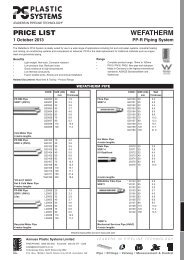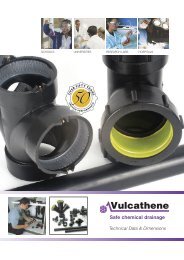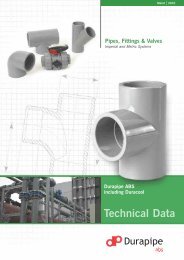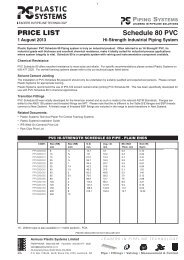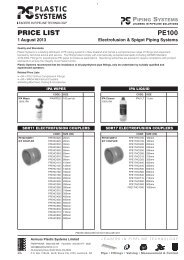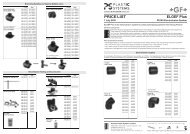Guide to Solvent Cementing PVC and CPVC Plastic ... - Glynwed Asia
Guide to Solvent Cementing PVC and CPVC Plastic ... - Glynwed Asia
Guide to Solvent Cementing PVC and CPVC Plastic ... - Glynwed Asia
You also want an ePaper? Increase the reach of your titles
YUMPU automatically turns print PDFs into web optimized ePapers that Google loves.
JOINING PLASTIC PIPE IN HOT WEATHER<br />
There are many occasions when solvent cementing plastic pipe at<br />
95°F (38°C) temperatures <strong>and</strong> above cannot be avoided. If special<br />
precautions are taken, problems can be avoided.<br />
<strong>Solvent</strong> cements for plastic pipe contain high strength solvents<br />
which evaporate faster at elevated temperatures. This is especially<br />
true when there is a hot wind blowing. If the pipe is s<strong>to</strong>red in direct<br />
sunlight, the pipe surface temperatures may be from 20°F <strong>to</strong> 30°F<br />
(10°C <strong>to</strong> 15°C) higher than the ambient temperature. <strong>Solvent</strong>s<br />
attack these hot surfaces faster <strong>and</strong> deeper, especially inside a<br />
joint. Therefore, it is very important <strong>to</strong> avoid puddling the cement<br />
inside the fitting socket <strong>and</strong> <strong>to</strong> wipe off any excess cement outside<br />
the joint.<br />
By following our st<strong>and</strong>ard instructions <strong>and</strong> using a little extra care,<br />
as outlined below, successful solvent cemented joints can be made<br />
in even the most extreme hot weather conditions.<br />
Tips <strong>to</strong> Follow when <strong>Solvent</strong> <strong>Cementing</strong> in High<br />
Temperatures:<br />
1. S<strong>to</strong>re solvent cements <strong>and</strong> primers in a cool or shaded area<br />
prior <strong>to</strong> use.<br />
2. If possible, s<strong>to</strong>re fittings <strong>and</strong> pipe or at least the ends <strong>to</strong> be<br />
solvent welded, in a shady area before cementing.<br />
3. Cool the surfaces <strong>to</strong> be joined by wiping with a damp rag. Make<br />
sure that surface is dry prior <strong>to</strong> applying solvent cement.<br />
4. Try <strong>to</strong> do the solvent cementing during the cooler morning hours.<br />
5. Make sure that both surfaces <strong>to</strong> be joined are still wet with<br />
cement when putting them <strong>to</strong>gether. With large diameter pipe,<br />
more people on the crew may be necessary.<br />
6. Using a primer <strong>and</strong> a heavier, high viscosity cement will<br />
provide a little more working time. Vigorously shake or stir the<br />
cement before using.<br />
As you know, during hot weather there can be a greater<br />
expansion-contraction fac<strong>to</strong>r. We suggest you follow the advice of<br />
the pipe manufacturer regarding this condition. Anchored, <strong>and</strong> final<br />
connections should be made during the cooler hours of the day.<br />
By using Weld-On products as recommended <strong>and</strong> by following<br />
these hot weather tips, making strong, leakproof joints even during<br />
very hot weather conditions can be achieved.<br />
15



